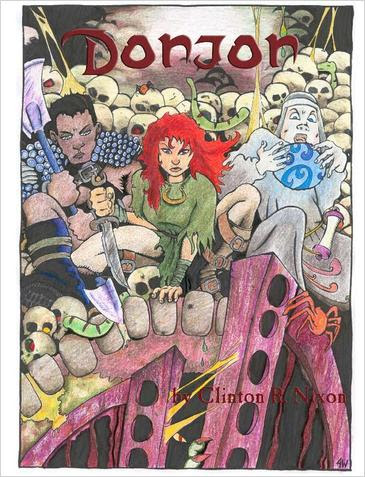I started to feel that I didn’t know roleplaying games well enough so I came up with the plan to read a roleplaying game corebook for every year they have been published. Selection criteria is whatever I find interesting.

In the early 2000’s when the play culture of my particular corner of the roleplaying scene was developing, players started to invent actionable world details. We called this the: “There’s a bar down the street. I go there” -method. The game was still led by a strong auteur GM but the culture developed so that players had the freedom to just come up with stuff based on their assessment of the style of the game.
Donjon came out in 2002 but I only read it now. It’s built on essentially the same idea, only it systematizes it into game mechanics. The idea is that as players succeed in their actions, they can decide details about the game world. A neat example is when you roll to find secret doors. If you succeed, you can decide there’s now a secret door, and the GM will improvise based on that.
The goal of Donjon is to generate play that’s as fun as D&D was when we played it for the first time as children. Reading it now feels like a mix of OSR and Forge vibes, but the freewheeling style is still very strong. Different roleplaying games work for different players and for Donjon, the ideal player seems to be someone who has some experience with improvising details, and who has a nostalgic attitude towards dungeon crawling.
I like the way the game challenges the GM, making the GM and the players almost like opponents in an improvisational free for all. At first I had trouble grasping the expected level of GM planning but then I read the example adventure and realized it’s very close to the kind of planning I do normally when I run my own games. Plan ready-made elements and then use and adapt those on the fly based on what the players are doing.
At the end of the book, there’s guidance on how to publish your own games. It’s a fun snapshot of an era 20 years ago with its talk of Adobe PageMaker and doing layout in HTML. One statement caught my eye, where it argues that making your game into a printed product doesn’t make it more valid. That’s obviously true if we consider nothing but the game itself and its design.
However, during this reading project and while hunting down old games I’ve learned that all platforms are not equal when it comes to how well your game will last through the decades. If it’s a physical book, there’s a chance someone like me will be able to hunt it down 20 years later and read it. If it’s a PDF, well… Sometimes it’s there and sometimes not.
If it has been published as a website or similar digital format, forget it. It’s gone.
I’m really enjoying this series. But is there a reason you haven’t included Apocalypse World or any of the Powered By The Apocalypse games?